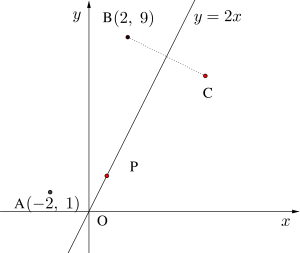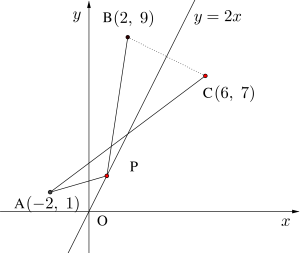こんにちは、リンス(@Lins016)です。
今回は点と直線について学習していこう。
点と直線
点と直線は、距離や対称な点などテストや入試で問われるパターンは決まっているから基本的な問題をきちんとおさえておくことが重要だ。
・\(\small{ \ ax+by+c=0 \ }\)と\(\small{ \ (p、q) \ }\)の距離\(\small{ \ d \ }\)
\(\small{ \ d=\displaystyle \frac{|ap+bq+c|}{\sqrt{a^2+b^2}} \ }\)
・\(\small{ \ ax+by+c=0 \ }\)について\(\small{ \ (p、q) \ }\)と対称な点\(\small{ \ (X、Y) \ }\)
\(\small{\begin{eqnarray}
\left\{
\begin{array}{l}
a\cdot\displaystyle \frac{X+p}{2}+b\cdot\displaystyle \frac{Y+q}{2}+c=0\\
-\displaystyle \frac{a}{b}\cdot \displaystyle \frac{Y-q}{X-p}=-1
\end{array}
\right.
\end{eqnarray} \ }\)
点と直線の距離の公式
これは確実に覚えておかないといけない公式の1つだよね。今回はまだ学習しないけど、円の接線の問題でもよく使うから、まだ覚えていないって人はかならず覚えておこう。ちなみに証明は点と直線の距離をみて確認しておこう。
直線に対称な点
直線に対称な点の求め方は
①対称な点同士の中点が直線上にある。
②対称な点を結ぶ直線と元の直線が垂直に交わる
これを式にして点を求めよう。どちらか1つだけを満たしても対称な点にはならないからきちんと2つの条件を満たそう。
\(\small{ \ 3 \ }\)点\(\small{ \ (0、0)、(a、b)、(c、d) \ }\)を頂点とする三角形の面積は\(\small{ \ \displaystyle \frac{1}{2}|ad-bc| \ }\)であることを示せ。
\(\small{ \ (0、0)、(a、b) \ }\)を通る直線の方程式は\(\small{ \ y=\displaystyle \frac{b}{a}x \ }\)\(\small{ \ \therefore ay-bx=0 \ }\)
\(\small{ \ ay-bx=0 \ }\)と\(\small{ \ (c、d) \ }\)の距離\(\small{ \ l \ }\)は
\(\small{ \ l=\displaystyle \frac{|ad-bc|}{\sqrt{a^2+b^2}} \ }\)
求める三角形の面積を\(\small{ \ S \ }\)とすると
\(\small{ \ S=\displaystyle \frac{1}{2}\sqrt{a^2+b^2}\cdot l=\displaystyle \frac{1}{2}|ad-bc| \ }\)


Point
①点と直線の距離の公式を覚えよう
②対称点は2つの条件を満たすことから求めよう
\(\small{ \ 2 \ }\)点\(\small{ \ \mathrm{A}(-2、1)、 \mathrm{B}(2、9) \ }\)と直線\(\small{ \ l:y=2x \ }\)がある。直線\(\small{ \ l \ }\)に関して点\(\small{ \ \mathrm{B} \ }\)と対称な点を\(\small{ \ \mathrm{C} \ }\)とする。また点\(\small{ \ \mathrm{P} \ }\)は直線\(\small{ \ l \ }\)上を動く点である。次の問いに答えよ。
(1)点\(\small{ \ \mathrm{C} \ }\)の座標を求めよ。
(2)\(\small{ \ \mathrm{AP}+\mathrm{BP} \ }\)が最小になるような点\(\small{ \ \mathrm{P} \ }\)の座標を求めよ。
(3)\(\small{ \ \angle\mathrm{APB}=90^{ \circ } \ }\)となるような点\(\small{ \ \mathrm{P} \ }\)の座標を求めよ。
線分\(\small{ \ \mathrm{BC} \ }\)の中点\(\small{ \ \left(\displaystyle \frac{a+2}{2}、\displaystyle \frac{b+9}{2}\right) \ }\)は直線\(\small{ \ l \ }\)上にあるから
\(\small{ \ \displaystyle \frac{b+9}{2}=2\cdot \displaystyle \frac{a+2}{2} \ }\)
\(\small{ \ \therefore b=2a-5\cdots① \ }\)
\(\small{ \ \mathrm{BC}\perp l \ }\)より
\(\small{ \ \displaystyle \frac{b-9}{a-2}\cdot2=-1 \ }\)
\(\small{ \ \therefore a+2b=20\cdots② \ }\)
\(\small{ \ ①② \ }\)より\(\small{ \ a=6、b=7 \ }\)
\(\small{ \ \therefore \ \mathrm{C}(6、7) \ }\)

(2)\(\small{ \ \mathrm{AP}+\mathrm{BP} \ }\)が最小になるのは\(\small{ \ \mathrm{AP}+\mathrm{BP}=\mathrm{AC} \ }\)のとき。
つまり点\(\small{ \ \mathrm{P} \ }\)は\(\small{ \ \mathrm{AC}:y=x+1 \ }\)と\(\small{ \ y=2x \ }\)の交点である。
\(\small{ \ \therefore \ \mathrm{P}(1、2) \ }\)

(3)\(\small{ \ \mathrm{P}(t、2t) \ }\)とおくと\(\small{ \ \angle\mathrm{APB}=90^{ \circ } \ }\)のとき
(\(\small{ \ \mathrm{AP} \ }\)の傾き)×(\(\small{ \ \mathrm{BP} \ }\)の傾き)\(\small{ \ =-1 \ }\)より
\(\small{ \ \displaystyle \frac{2t+1}{t+2}\cdot\displaystyle \frac{2t-9}{t-2}=-1 \ }\)
整理して\(\small{ \ 5t^2-16t-13=0 \ (t\neq \pm2) \ }\)
\(\small{ \ \therefore \ t=\displaystyle \frac{8\pm \sqrt{129}}{5} \ }\)


